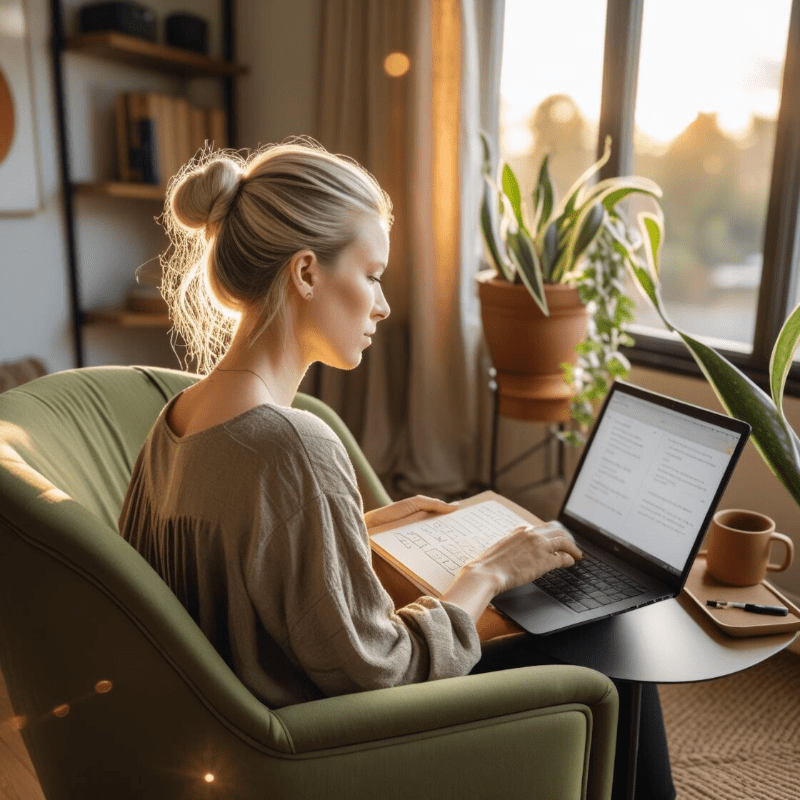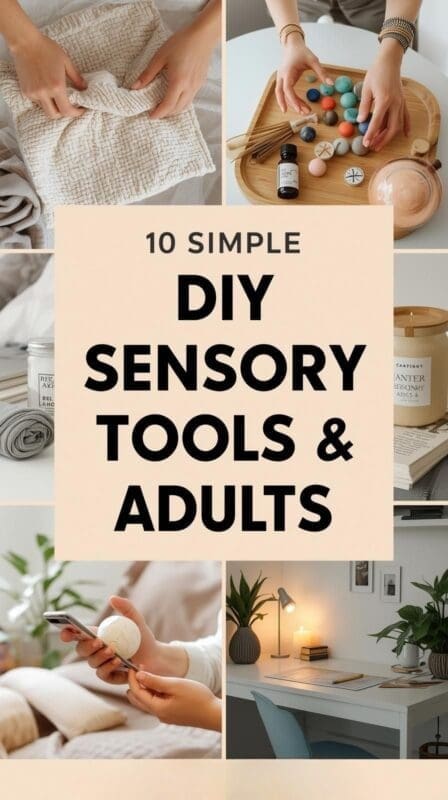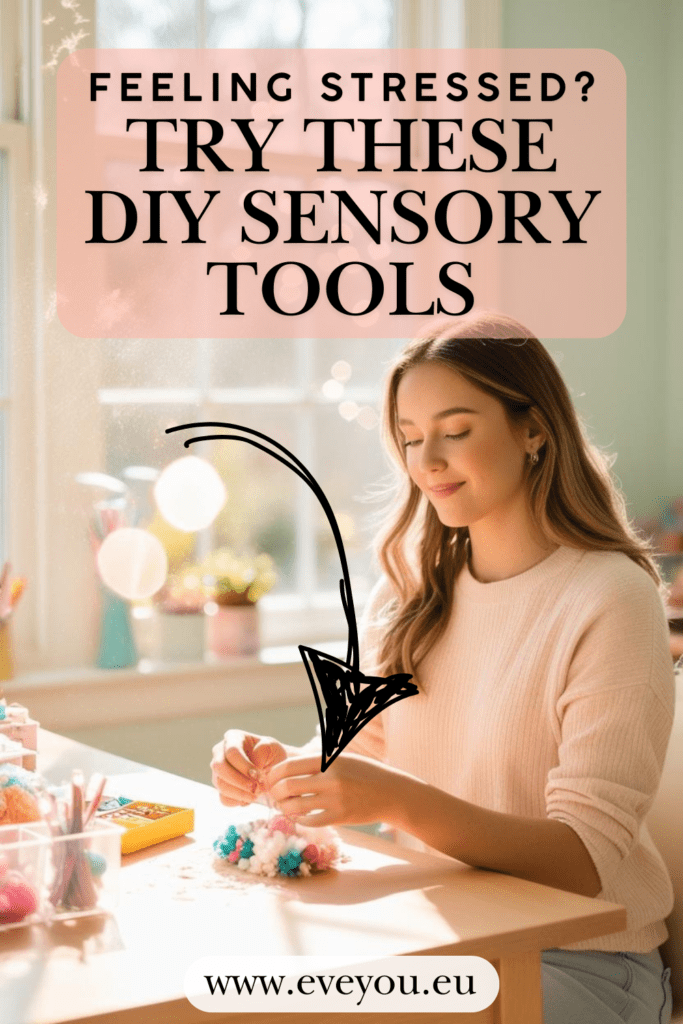Relax and Rewind: Simple DIY Sensory Tools and Techniques for Adults
After a long, stressful day, it’s easy to feel drained, overwhelmed, and out of balance. Work deadlines, family responsibilities, and the general busyness of life can leave us feeling like we need a reset. But what if there was an easy, effective way to help your mind and body unwind? Enter sensory tools.
Sensory tools are simple items or techniques that engage your senses in ways that promote relaxation, reduce stress, and help you feel grounded. The best part? Many of them can be easily made at home with items you already have on hand, or with minimal investment. These tools can be used to calm your nervous system, improve your focus, and simply help you unwind when life gets a little too overwhelming.
In this post, we’ll take a closer look at different types of sensory tools, how they work to help you relax, and share step-by-step guides for making and using them.
Sensory Tools and Their Benefits
Before we dive into creating your own tools, let’s take a moment to understand why these tools are so effective. Sensory tools help engage your body’s natural sensory pathways to activate the parasympathetic nervous system—the part of your body responsible for “rest and digest” functions. When engaged, this system helps lower your heart rate, reduce muscle tension, and calm your mind.
Let’s break down a few types of sensory tools and how they can work for you:
- Stress Balls: These handy little tools help engage your sense of touch and promote relaxation by providing tactile stimulation. Squeezing a stress ball can release built-up tension in your hands and wrists while giving you a focus point to channel any anxiety.
- Textured Fabrics: Different textures, like soft fabrics, rough surfaces, or even fabrics with different textures sewn together, can offer calming sensory feedback. Touching and running your hands over these textures can be soothing and help redirect anxious thoughts.
- Essential Oils: Scent plays a huge role in how we feel. Aromatherapy, which uses essential oils to promote relaxation and well-being, has been shown to lower stress and anxiety. Scents like lavender, chamomile, and eucalyptus are known for their calming properties.
- Visualization Techniques: Sometimes, sensory engagement isn’t just about physical objects—it’s about what you imagine. Visualization techniques can tap into your sense of sight and calm your nervous system by focusing on positive, calming imagery.
Now that we know why these tools work, let’s dive into how to make them and how to use them effectively.
The Science Behind Sensory Tools
Sensory tools engage the body’s natural sensory pathways to activate the parasympathetic nervous system—the part responsible for rest, digestion, and recovery. When you use your senses intentionally (through touch, scent, sound, or temperature), your body releases tension, lowers cortisol, and restores balance.
The goal isn’t to distract yourself from stress—it’s to ground yourself in the present moment. These tools can become daily rituals of self-care, helping you move from “survival mode” to “calm focus.”
How to Incorporate Sensory Tools Into Everyday Life
Before diving into specific ideas, it’s worth planning how you’ll use them. Many people buy or make sensory tools but forget to integrate them into their day.
Here’s how to get started:
- Choose 2–3 tools you’ll actually reach for (one tactile, one scent-based, one visual or auditory).
- Keep them visible. Place a stress ball on your desk, a relaxation jar by your bed, or a texture square in your bag.
- Use them preventatively, not just when overwhelmed. A few minutes of calming input during the day prevents stress from building up.
- Pair with breathing. Using deep, slow breaths while engaging the senses enhances the calming effect.
Now that you know the “why” and “when,” let’s explore even more how.
DIY Sensory Tools You Can Create at Home
Here are some easy, cost-effective sensory tools you can create at home, along with step-by-step instructions for making and using each one.
1. DIY Stress Ball
A stress ball is one of the most common sensory tools, and it’s incredibly easy to make with just a few simple materials.
What you’ll need:
- A balloon
- Rice, flour, or cornstarch (for filling)
- A funnel or spoon (for filling the balloon)
- Scissors
Step-by-Step Guide:
- Prepare the Balloon: Stretch the balloon by gently pulling it. This makes it easier to fill.
- Fill the Balloon: Using a funnel or spoon, fill the balloon with your desired filling—rice, flour, or cornstarch work well. You can experiment with different fillings to see which one gives you the most satisfying squeeze. Be sure not to overfill it; leave some space so the ball has room to squish.
- Tie the Balloon: Once it’s filled to your satisfaction, tie the balloon tightly to prevent any spills.
- Trim the End: Cut off any excess balloon at the top to make it neat.
- Test It: Give it a squeeze! The stress ball should be firm yet squeezable. If it’s too hard, try adjusting the filling.
How to Use: Whenever you’re feeling stressed, squeeze the ball in your hands to release tension. Focus on the sensation of the ball compressing and expanding. This can be a quick and easy way to bring your body back into a relaxed state.
2. Textured Fabric Squares for Relaxation
Using textured fabrics can have a grounding effect on your body and mind. The variety of textures can engage your sense of touch and bring focus to the present moment.
What you’ll need:
- Several different types of fabric (soft cotton, velvet, linen, burlap, etc.)
- Scissors
- Needle and thread or fabric glue
Step-by-Step Guide:
- Choose Your Fabrics: Select a few fabrics with different textures that feel good to you. You might prefer something soft and plush, or something rough like burlap.
- Cut the Fabric: Cut the fabric into small squares (around 4” x 4” is ideal).
- Sew or Glue the Edges: To avoid fraying, either sew or glue the edges of each square. If you prefer a no-sew option, fabric glue works wonders!
- Layer and Combine: You can even combine textures by sewing or gluing two different fabrics together to create a more stimulating experience.
How to Use: When you’re feeling anxious or stressed, hold the fabric square in your hands and run your fingers over the different textures. Focus on the feeling of the fabrics in your hands, noticing any changes in temperature, softness, or texture. This mindful engagement with your senses can help calm your body and mind.
3. Essential Oil Relaxation Kit
Essential oils are well-known for their calming and soothing effects. Whether you use them in a diffuser, in a roller bottle, or just inhale them directly, these oils can significantly reduce stress and anxiety.
What you’ll need:
- A small glass jar or roller bottle
- Essential oils (lavender, chamomile, or eucalyptus are great for relaxation)
- Carrier oil (like coconut or jojoba oil)
- A diffuser (optional)
Step-by-Step Guide:
- Prepare Your Blend: If you’re using a roller bottle, add 10-15 drops of your chosen essential oil or a combination of oils into the bottle. Fill the rest of the bottle with carrier oil to dilute the essential oils.
- Use the Roller Bottle: Roll a little of the essential oil blend onto your wrists, neck, or temples when you need to relax. Close your eyes, take a few deep breaths, and allow the scent to calm your nerves.
- Using a Diffuser: If you prefer using a diffuser, add water to the diffuser, followed by 5-10 drops of essential oil. Turn it on and allow the scent to fill the room.
How to Use: Keep your essential oils close by throughout the day—on your desk, in your bag, or by your bed. When stress starts to build up, take a moment to inhale deeply from the oil or rub some onto your wrists. You’ll be amazed at how quickly your body starts to unwind.
4. Visualization Technique for Stress Relief
Sometimes the most powerful tool isn’t something you can hold—it’s the power of your mind. Visualization techniques use the imagination to create a calming mental image that can help soothe your nervous system.
What you’ll need:
- A quiet, comfortable space
- A few minutes of uninterrupted time
- A calm, focused mind
Step-by-Step Guide:
- Find a Comfortable Space: Sit or lie down in a quiet, comfortable space where you won’t be disturbed.
- Close Your Eyes and Breathe: Take a few deep breaths to help your body relax and bring your focus to the present moment.
- Imagine a Calming Scene: Picture a peaceful scene in your mind—perhaps a quiet beach, a calm forest, or a cozy room. Use all your senses to make the image vivid. Hear the waves crash, feel the breeze, or smell the fresh air.
- Stay in the Moment: Let your mind fully immerse in the imagery. Spend a few minutes in this peaceful state before slowly bringing yourself back to the present.
How to Use: This technique can be done anytime, anywhere—whether you’re in the middle of a stressful workday or just before bed. The key is to create a mental space where you feel safe, relaxed, and at ease.
5. DIY Fidget Stone
Why it helps: The weight and texture provide grounding tactile feedback. Smooth surfaces and gentle pressure reduce fidgeting and restlessness.
What you’ll need:
- Air-dry clay or polymer clay
- Optional: mica powder or matte varnish
How to make: Mold clay into a palm-sized oval, pressing your thumb gently into one side to form an indentation. Let dry according to package instructions.
How to use: Keep it in your pocket or on your desk. When anxious, run your thumb over the indent and focus on the sensation.
You can find detailed explanation about DIY Fidget Stones HERE
Conclusion
Sensory tools are a simple yet powerful way to help you relax, unwind, and reset your mind and body after a busy day. Whether you’re squeezing a DIY stress ball, running your fingers over soft fabric, inhaling a calming essential oil, or using the power of visualization, these techniques can help reduce stress and boost your mood.
The beauty of sensory tools is that they can be made easily at home with minimal materials, and they’re effective in providing quick relief when you need it most. By incorporating these simple yet powerful tools into your routine, you can start to find peace and balance amidst the busyness of life.
Try making and using these tools today, and notice how they can bring you moments of calm and relaxation. You deserve to feel your best—and these sensory tools can help you get there.

About the Author
Hi, I’m Eve, a former school counselor with a master’s degree in School Psychology and a passionate advocate for children and families navigating sensory challenges. As a mom of children with sensory sensitivities, I deeply understand the journey special-needs parents face, and I dedicate myself to researching and sharing practical solutions to help children thrive and feel comfortable in their bodies. My goal is also to empower counselors, therapists, and psychologists with creative strategies and supportive resources to enrich their everyday practice. When I’m not writing or exploring new therapeutic approaches, you’ll find me spending quality time with my family and continually seeking inspiration from everyday moments.





